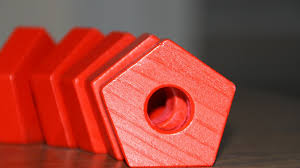A Shape Beyond BordersHave you ever stopped to marvel at the elegance of geometric shapes? Among them, one stands out not just for its unique structure but also for its profound significance in various fields. Enter the pentagon — a five-sided polygon that’s more than just a figure on paper; it embodies concepts of balance, stability, and beauty. In this blog post titled “shape:yl6axe4-ozq= pentagon,” we’ll dive deep into the world of pentagons, exploring their mathematical properties, real-world applications, and even their cultural symbolism. Whether you’re a math enthusiast or just curious about geometry’s impact on our lives, get ready to discover how this simple shape can unlock complex ideas and inspire creativity!
Introduction to the Shape:yl6axe4-ozq= Pentagon
Welcome to the fascinating world of shapes! Today, we’re diving into a geometric gem that captures both beauty and intrigue: the shape:yl6axe4-ozq= pentagon. This five-sided wonder is not just a staple in mathematics; it has carved its niche across art, architecture, and nature. With its unique angles and symmetry, the pentagon stands as a symbol of harmony and balance. Whether you’re an avid geometry enthusiast or simply curious about this captivating shape, get ready to explore everything there is to know about the remarkable pentagon!
History and Background of the shape:yl6axe4-ozq= pentagon
The shape:yl6axe4-ozq= pentagon has a rich history that dates back to ancient civilizations. Early mathematicians studied this five-sided figure, intrigued by its symmetry and balance. Ancient Greeks were particularly fascinated, incorporating it into their architectural designs and artistic expressions.
In geometry, the term “pentagon” comes from the Greek word “pente,” meaning five. This shape often appears in various cultures around the world, serving both practical and symbolic purposes.
During the Renaissance, artists like Leonardo da Vinci explored geometric shapes extensively. The pentagon became a crucial part of his studies in proportion and harmony.
Today, many still admire its aesthetic appeal and mathematical properties. Whether seen in nature or human-made structures, the pentagon remains an enduring symbol of beauty throughout history.
Characteristics and Properties of a shape:yl6axe4-ozq= pentagon
The shape:yl6axe4-ozq= pentagon is a fascinating geometric figure. It consists of five sides and five angles, which sets it apart from many other shapes.
Each interior angle in a regular pentagon measures 108 degrees, contributing to its distinct appearance. The sum of all internal angles reaches an impressive 540 degrees.
Regular pentagons also display symmetry. They can be rotated around their center point without changing their appearance, showcasing elegance in design.
Another interesting property is the relationship between its sides and diagonals. A regular pentagon has five diagonals, connecting non-adjacent vertices and creating captivating patterns within the shape.
Additionally, when you calculate the area using side length ( s ), the formula becomes ( \frac{1}{4} \sqrt{5(5 + 2\sqrt{5})} s^2 ). This mathematical aspect adds another layer to understanding this unique polygon.
Types of shape:yl6axe4-ozq= pentagon
shape:yl6axe4-ozq= pentagon come in various shapes and sizes, each with unique characteristics. The most common type is the regular pentagon, where all sides and angles are equal. This symmetry gives it a pleasing aesthetic.
Next, we have irregular pentagons. These don’t share equal lengths or angles but still maintain five sides. Their varied forms can create interesting designs in art and architecture.

Another fascinating category is the convex pentagon. Here, all interior angles are less than 180 degrees, allowing for a bulging outline that feels inviting.
Conversely, concave pentagons feature at least one angle greater than 180 degrees. This creates an inward dent that adds complexity to their shape.
Lastly, star-shaped pentagons combine lines extending outward from the vertices creating a striking visual effect often seen in decorative motifs or graphics. Each type of Pentagon brings its charm to geometry!
How to Draw a Perfect shape:yl6axe4-ozq= pentagon
Drawing a perfect shape:yl6axe4-ozq= pentagon can be both fun and satisfying. Start with a blank sheet of paper and a pencil.
First, use a compass to draw a circle. This will serve as your guide for the pentagon’s size. Mark the center point clearly.
Next, divide the circle into five equal sections using a protractor. Each angle should measure 72 degrees—this is vital for symmetry.
Once you’ve marked all five points on the circumference, connect them with straight lines. Use a ruler for precision to ensure clean edges.
Don’t forget to erase any extra marks from your initial steps; clarity makes your shape stand out beautifully!
Feel free to add color or patterns once you’re satisfied with your pentagon’s structure!
Real-Life Examples and Uses of shape:yl6axe4-ozq= pentagon
shape:yl6axe4-ozq= pentagon are more than just a mathematical curiosity. They appear in various aspects of our daily lives, showcasing their unique shape and utility.
One notable example is the design of certain sports fields, such as soccer pitches. The pentagon’s geometry can help create balanced layouts for both playability and aesthetics.
Architecture also embraces the pentagon. Some modern buildings incorporate this shape to enhance visual interest and structural integrity. The Pentagon building in Arlington, Virginia, stands as an iconic testament to this geometric form.
In nature, you can find pentagonal patterns in starfish or certain flowers. These examples highlight how essential shapes are woven into life itself.
Even tabletop games use pentagons! Certain board games feature pieces shaped like this five-sided figure, adding fun dynamics to gameplay while captivating players with its distinct look.
Fun Facts about the shape:yl6axe4-ozq= pentagon
The pentagon shape is fascinating and full of surprises. It’s not just a geometric figure; it has historical significance too.
Did you know that the word “pentagon” comes from the Greek words “pente,” meaning five, and “gonia,” which translates to angle? This reflects its five-sided nature perfectly.
In nature, pentagons can be found in starfish and some flowers like the popular petunia. These natural occurrences highlight the beauty of symmetry in our world.
Architecturally, one of the most famous buildings shaped like a pentagon is none other than The Pentagon in Washington D.C. It serves as a symbol of military strength and strategy.
Artists also love this shape:yl6axe4-ozq= pentagon! Its unique angles inspire creativity, leading to beautiful designs in art and architecture everywhere you look.
Conclusion
The shape:yl6axe4-ozq= pentagon holds a unique place in both mathematics and design. Its five sides create a harmonious balance that is visually appealing and structurally significant. This geometric figure has influenced architecture, art, and nature alike.
From the ancient Greeks to modern-day designers, the pentagon continues to inspire creativity. Whether it’s found in urban planning or as part of everyday objects, its versatility cannot be understated.
Understanding this shape enhances our appreciation for geometry. It showcases how simple shapes can have profound implications in various fields—from engineering to aesthetics.
As we explore more about shapes around us, let’s remember the beauty of the pentagon—a perfect blend of form and function that enriches our lives in subtle yet meaningful ways.




